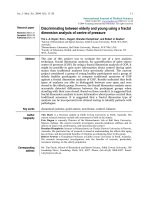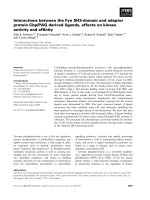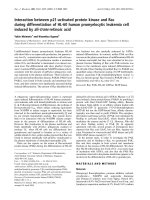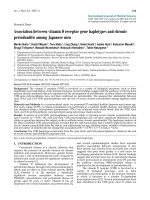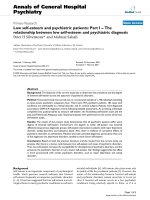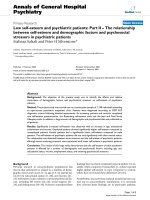Báo cáo y học: "Communication between secondary and primary care following self-harm: are National Institute of Clinical Excellence (NICE) guidelines being met" ppsx
Bạn đang xem bản rút gọn của tài liệu. Xem và tải ngay bản đầy đủ của tài liệu tại đây (212.65 KB, 5 trang )
BioMed Central
Page 1 of 5
(page number not for citation purposes)
Annals of General Psychiatry
Open Access
Primary research
Communication between secondary and primary care following
self-harm: are National Institute of Clinical Excellence (NICE)
guidelines being met?
Jayne Cooper*
1
, Elizabeth Murphy
1
, Rita Jordan
2
and Kevin Mackway-Jones
3
Address:
1
Community Based Medicine, Department of Psychiatry, University of Manchester, UK,
2
Manchester Mental Health and Social Care Trust,
Manchester, UK and
3
Emergency Medicine Research Group, Manchester Royal Infirmary, Manchester, UK
Email: Jayne Cooper* - ; Elizabeth Murphy - ;
Rita Jordan - ; Kevin Mackway-Jones -
* Corresponding author
Abstract
Background: Most patients contact their general practitioner (GP) following presentation to an
Emergency Department (ED) after a self-harm incident, and strategies to help GPs manage these
patients include efficient communication between services. The aim of this study was to assess the
standard of documentation and communication to primary care from secondary care as
recommended by the National Institute of Clinical Excellence (NICE) guidelines on the short-term
management of people who self-harm.
Methods: An audit of medical records (ED and Psychiatric) on people aged 16 years and over who
had presented to the ED following self-harm, benchmarked according to government guidelines,
was performed. Data were collected over a 4-week period at a general teaching hospital.
Results: We collected data on 93 consecutive episodes of self-harm; 62% of episodes were
communicated to primary care, 58% of these communications were within 24 h and most within 3
days. Patient identifying details and follow-up arrangements were specified in most cases.
Communication via psychiatric staff was most detailed. ED clinicians provided few communications
and were of limited content. Communication with the patient's GP was not made in half of those
cases seen by a mental health specialist.
Conclusion: Government guidelines are only partially being met. Reliance on communication by
ED staff would leave a substantial proportion of patients discharged from the ED with no or
minimal communication to primary care. Psychiatric services need to improve the rate of
communication to the patient's GP following assessment A national sample of National Health
Service (NHS) trusts would establish if this is a problem elsewhere.
Background
General Practitioners (GPs) are pivotal in the manage-
ment of patients who self-harm. A recent review [1] sug-
gested that one strategy that helps GPs manage these
patients is efficiency of communication between second-
ary and primary care. Most patients who present to the
Emergency Department (ED) with self-harm consult their
GP soon afterwards [2,3]. Many of these patients present
Published: 23 October 2008
Annals of General Psychiatry 2008, 7:21 doi:10.1186/1744-859X-7-21
Received: 28 January 2008
Accepted: 23 October 2008
This article is available from: />© 2008 Cooper et al; licensee BioMed Central Ltd.
This is an Open Access article distributed under the terms of the Creative Commons Attribution License ( />),
which permits unrestricted use, distribution, and reproduction in any medium, provided the original work is properly cited.
Annals of General Psychiatry 2008, 7:21 />Page 2 of 5
(page number not for citation purposes)
with physical complaints, which may disguise an underly-
ing risk of psychological problems [4]. At first point of
contact after an episode of self-harm, the patient may be
unknown to the GP. Prior knowledge of this history
should assist in their assessment, yet less than half (41%)
of GPs receive a discharge summary [5].
Clinical practice guidelines are systematically-developed
statements that aim to assist physicians in supplying the
appropriate health care for specific clinical circumstances
[6]. Government guidelines in the UK provide recommen-
dations for practice based on the best available evidence.
One such guideline on the short-term management of
self-harm patients in secondary care recommends that all
patients presenting with self-harm should receive a psy-
chosocial needs assessment including social, psychologi-
cal and motivational factors, and mood and risk [7]. This
information should be passed on to GP 'as soon as possi-
ble'. Mental capacity and evidence of mental illness
should be communicated to GPs if patients leave before a
specialist assessment. The guidelines endorse the Royal
College of Psychiatrists' (RCP) recommendations [8] on
the content of these communications. However, imple-
mentation of National Institute of Clinical Excellence
(NICE) guidelines has been variable [9].
In light of developments in national policies and further
research, the Royal College of Psychiatrists produced a
revision of their earlier document [10] on a consensus of
standards for assessment following self-harm. Several
standard competencies (for non-specialist staff and spe-
cialist staff) were recommended [8]: psychosocial assess-
ments should ideally be carried out by specialist staff;
medical staff may undertake assessments if trained for the
task; where a patient is not admitted or assessed by a spe-
cialist, ED staff should record information according to
the recommended list below, which should be passed
onto the GP; there should be a policy for referral to spe-
cialists for patients admitted to general medical wards;
and information from assessments should be passed on to
the GP (by fax) within 24 hrs and written communication
within 3 working days. The recommended patient infor-
mation to be obtained before discharge following self-
harm included specific arrangements for any follow-up if
not referred on for specialist opinion.
The aims of the present study were to assess the standard
of documentation and communication after presentation
to an ED in the northwest of England with self-harm of
patients aged 16 years and over, based on national guide-
lines. Our objectives were to assess: the proportion of self-
harm cases that were discharged from EDs that were noti-
fied to primary care services; the content and nature of
communications from EDs to primary care services about
such patients; the proportion of self-harm cases that were
assessed by psychiatric services that were notified to pri-
mary care services; the content and nature of communica-
tions from psychiatric services to primary care services
about such patients; and the timing of communication
between EDs/psychiatric services to primary care services.
Definition of self-harm
Self-harm is defined as intentional self-poisoning or self-
injury, irrespective of motivation [11]. Self-poisoning
includes the intentional self-ingestion of more than the
prescribed amount of any drug, whether or not there is
evidence that the act was intended to result in death. This
also includes poisoning with non-ingestible substances
and gases, overdoses of 'recreational drugs' and severe
alcohol intoxication where clinical staff considers such
cases to be an act of intentional self-harm (rather than rec-
reational binge drinking). Self-injury is defined as any
injury that has been intentionally self-inflicted.
Service configuration
Service configuration at the study hospital included psy-
chiatric nurse led ED liaison team (operating 7 days a
week from 9 am to 10 pm). The on-call junior doctors in
psychiatry are available 24 h a day. In addition the Self-
Harm, Assessment, Follow-up and Engagement (SAFE)
Team assess people who present with self-harm and live
within the catchment area and are registered with a GP.
GPs may receive correspondence based on ED records if
patients have not been assessed by psychiatric services and
are out of area. Within the ED, it is incumbent upon the
doctor to make appropriate arrangements for follow-up.
Methods
This was a prospective case note study using ED/medical/
mental health records in a general teaching hospital in the
northwest of England, UK. All episodes of self-harm of
patients 16 years and over between 18 January and 14
February 2006 were identified using information from a
monitoring database of self-harm known as the Manches-
ter Self-Harm (MaSH) project [12]. We completed a pro-
forma on all episodes. The proforma was based on
criterion derived from NICE guidelines and RCP recom-
mendations.
Results
During the 4-week period there were 93 episodes of self-
harm, 40% male, 60% female (aged between 16–73
years). In total there was evidence of communication to
the patient's GP in 58/93 (62%) of cases. The source of
these communications included 26 from psychiatric staff
only, 3 from ED staff only, 3 from both psychiatric staff
and ED staff and 26 from the SAFE liaison service. The
speed of communications (percentage of all communica-
tions) was 34/58 (59%) of episodes within 24 h, 19/58
(33%) within 3 days and 5/58 (9%) after 3 days. The
Annals of General Psychiatry 2008, 7:21 />Page 3 of 5
(page number not for citation purposes)
method of communication (percentage of the total 58
communications) was predominantly by fax with 52/58
(90%), 3/58 (5%) by letter and in 3/58 (5%) the method
was not recorded. Table 1 provides a breakdown of the
content of these communications and by discipline.
Communications by ED staff
ED staff completed a psychosocial assessment on 47/93
(51%) of episodes. In 74% of episodes, patients were
either admitted to medical ward and/or seen by Psychiat-
ric services, with no follow-up in 26% of episodes. Of
those without follow-up, ED staff communicated with the
patient's GP in 13% of episodes and all communications
were made within 24 h.
Communications by psychiatric staff (not including SAFE
liaison service)
Psychiatric staff assessed 56/93 (60%) episodes, and 29/
56 (52%) of these assessments were communicated to the
GP. Duty doctors were responsible for a large proportion
of assessments (43/56, 77%) and 19/43 (44%) were com-
municated to the GP. Liaison nurses communicated 5/8
(63%) and SAFE team 5/5 (100%) of their assessments.
Communications by SAFE liaison service
The psychiatric service configuration at the study hospital
however enabled a further 26 episodes to be communi-
cated to the GP based on information gleaned from ED
records (SAFE Liaison service). Figure 1 illustrates the serv-
ice provision pathway and communication to primary
care following an episode of self-harm.
Conclusion
Nearly all self-harm episodes at the study hospital were
either seen by specialist psychiatric staff, or a member of
the SAFE team would write to the patients' GP, if regis-
tered, using information available from ED records. How-
ever, for those individuals not seen and assessed by
specialist staff this information was limited. Communica-
tion with the patient's GP was not made in half of those
cases seen by a mental health specialist. We suggest that
psychiatric services (particularly doctors as they appear to
assess proportionately more patients) need to improve
the rate of communication to the patient's GP following
assessment.
Although the SAFE team provide a liaison or "add-on
communication service" for those not seen by a specialist,
they cannot compensate for the lack of information
recorded by ED staff. Reliance on communication by ED
staff would leave a substantial proportion of patients dis-
charged from the ED with no or minimal communication
to primary care. A national sample of NHS trusts would
establish if this is a problem elsewhere. EDs must have
procedures in place to aid communication between the
psychiatric service and primary care if discharge directly
from the ED. We suggest that ED staff protocol might
include completion of an initial psychosocial assessment
using a proforma designed for the task, which could be
forwarded directly to primary care.
Due to increased specialization of service provision and
subsequent criteria for meeting inclusion, patients remain
liable to fall between service boundaries. This leaves an
Table 1: Content of communications from secondary services to primary care services according to recommendations by Royal
College of Psychiatrists (2004)
Type of information Any communication,
including SAFE liaison
follow-up
(n = 58)
Emergency
Department staff only
(n = 3)
Psychiatric services
(n = 29)
SAFE liaison follow-up
letter
(n = 26)
Name/age/date of birth 58/58 3/3 29/29 26/26
Past psychiatric history 23/58 0/3 23/29 0/26
Past history of self-harm 8/58 0/3 8/29 0/26
Comment on mood 22/58 0/3 21/29 1/26
Reference to alcohol 22/58 0/3 11/29 11/26
Reference to drugs 3/58 0/3 3/29 0/26
Precipitating circumstances 26/58 0/3 22/29 4/26
Follow-up arrangements 57/58 3/3 29/29 25/26
SAFE, Self-Harm, Assessment, Follow-up and Engagement.
Annals of General Psychiatry 2008, 7:21 />Page 4 of 5
(page number not for citation purposes)
important role for GPs. External validity of the study is
limited to EDs in urban areas with similar service provi-
sion and variability in organisations and provision of
service for this group has been reported in the UK [13].
The study demonstrates that even with a bespoke self-
harm service these patients can fall between service provi-
sions. This emphasises the role of ED staff in the subse-
quent psychosocial management of self-harm patients.
Competing interests
The authors declare that they have no competing interests.
Authors' contributions
JC and KM-J, designed the original study. RJ collected the
data, and EM and JC analyzed and interpreted the data. JC
wrote the article with contributions from EM, RJ and KM-
J. All authors read and approved the final manuscript.
Acknowledgements
The authors thank Ben Heyworth and Suzanne Robins for their help in
designing the proforma and Dr Alan Grayson for his assistance with data
collection in the ED. The authors also thank Iain Donaldson from the Man-
chester Self-Harm Project for his assistance with data collection.
The project was funded by the audit departments of the Manchester Mental
Health and Social Care Trust and Central Manchester and Manchester Chil-
drens' University Hospitals NHS Trust.
References
1. Mitchell AJ, Kingdon D, Cross I: Management of self-harm fol-
lowing hospital discharge: role for general practitioners in
continuity of care. Primary Care Comm Psychiatry 2005, 10:149-158.
2. Gunnell D, Bennewith O, Peters T, Stocks N, Sharp D: Do patients
who self-harm consult their general practitioner soon after
hospital discharge? A cohort study. Soc Psychiatry Psychiatr Epide-
miol 2002, 37:599-602.
3. Crawford MJ, Wessely S: The management of patients follow-
ing deliberate self-harm – what happens to those discharged
from hospital to GP care? Primary Care Psychiatr 2000, 6:61-65.
4. Masood-ul-Hasan S, Owens D: Self-poisoning patients in the
general hospital: the frequency and nature of their consulta-
tions with the general practitioner. Irish J Psychol Med 2003,
20:15-17.
5. McCauley M, Russell V, Bedford D, Khan A, Kelly R: Assessment
following deliberate self-harm: who are we seeing and are we
following the guidelines? Irish J Psychol Med 2001, 18:116-119.
6. Campbell F, Dickinson H, Cook J, Beyer F, Eccles M, Mason J: Meth-
ods underpinning national clinical guidelines for hyperten-
sion: describing the evidence shortfall. BMC Health Serv Res
2006, 6:47.
7. National Institute for Clinical Excellence: Self-harm: the short-term phys-
ical and psychological management and secondary prevention of self-harm
in primary and secondary care. Clinical guideline 16 London, UK: Gaskell
& British Psychological Society; 2004.
8. Royal College of Psychiatrists: Assessment following self-harm in adults
London, UK: Royal College of Psychiatrists; 2004.
9. Sheldon T, Cullum N, Dawson D, Lankshear A, Lowson K, Watt I,
West P, Wright D, Wright J: What's the evidence that NICE
guidance has been implemented? Results from a national
evaluation using time series analysis, audit of patients' notes,
and interviews. BMJ 2004, 329:999-1003.
10. Royal College of Psychiatrists: The general hospital management of adult
deliberate self-harm: a consensus statement on standards for service provi-
sion. Council report 32 London: Royal College of Psychiatrists; 1994.
11. Hawton K, Harriss L, Hall S, Simkin S, Bale E, Bond A: Deliberate
self-harm in Oxford, 1990–2000: a time of change in patient
characteristics. Psychol Med 2003, 33:987-995.
Communication with the General Practitioner by service provision pathwayFigure 1
Communication with the General Practitioner by service provision pathway.
Total Presentations
= 93
Seen by Psychiatry
= 56
Admitted/medical services
(+ not seen by Psych) = 13
Seen by ED only = 24
(19 treated.
5 DNW)
Communication with GP?
Yes = 29/56
No = 27/56
SAFE Liaison
Yes = 9/13
No = 4/13 (2 had no GP)
Communication with GP?
Yes = 3/24
No = 21/24 (incl 5 DNW)
SAFE Liaison
Yes = 17/21
(no = 4/21
(3 had no GP)
Publish with BioMed Central and every
scientist can read your work free of charge
"BioMed Central will be the most significant development for
disseminating the results of biomedical research in our lifetime."
Sir Paul Nurse, Cancer Research UK
Your research papers will be:
available free of charge to the entire biomedical community
peer reviewed and published immediately upon acceptance
cited in PubMed and archived on PubMed Central
yours — you keep the copyright
Submit your manuscript here:
/>BioMedcentral
Annals of General Psychiatry 2008, 7:21 />Page 5 of 5
(page number not for citation purposes)
12. Cooper J, Lawlor M, Hiroeh U, Kapur N, Appleby L: Factors that
influence emergency department doctors' assessment of sui-
cide risk in deliberate self-harm patients. Eur J Accident Emerg
Med 2003, 10:283-287.
13. Bennewith O, Gunnell D, Peters T, Hawton K, House A: Variations
in the hospital management of self-harm in adults in Eng-
land: observational study. BMJ 2004, 328:1108-1109.
